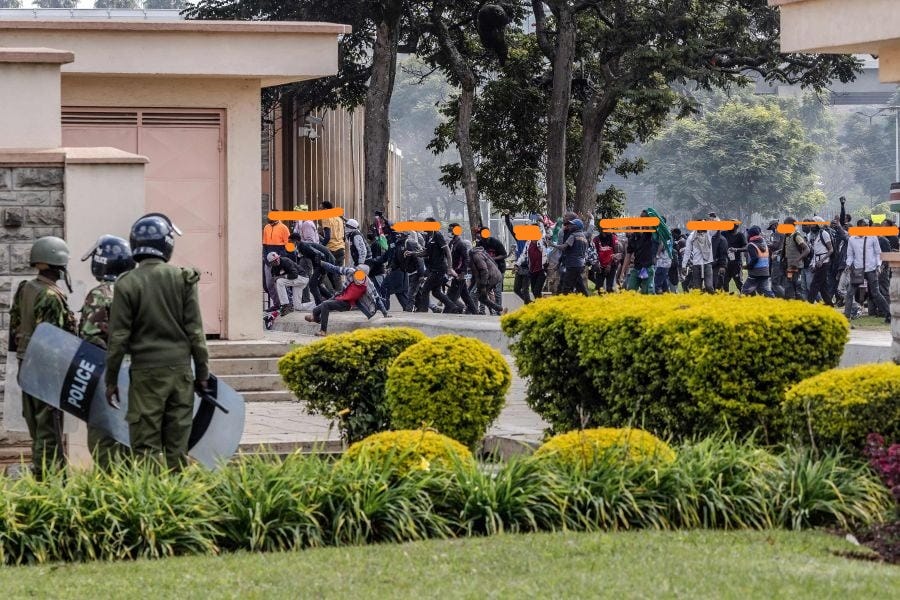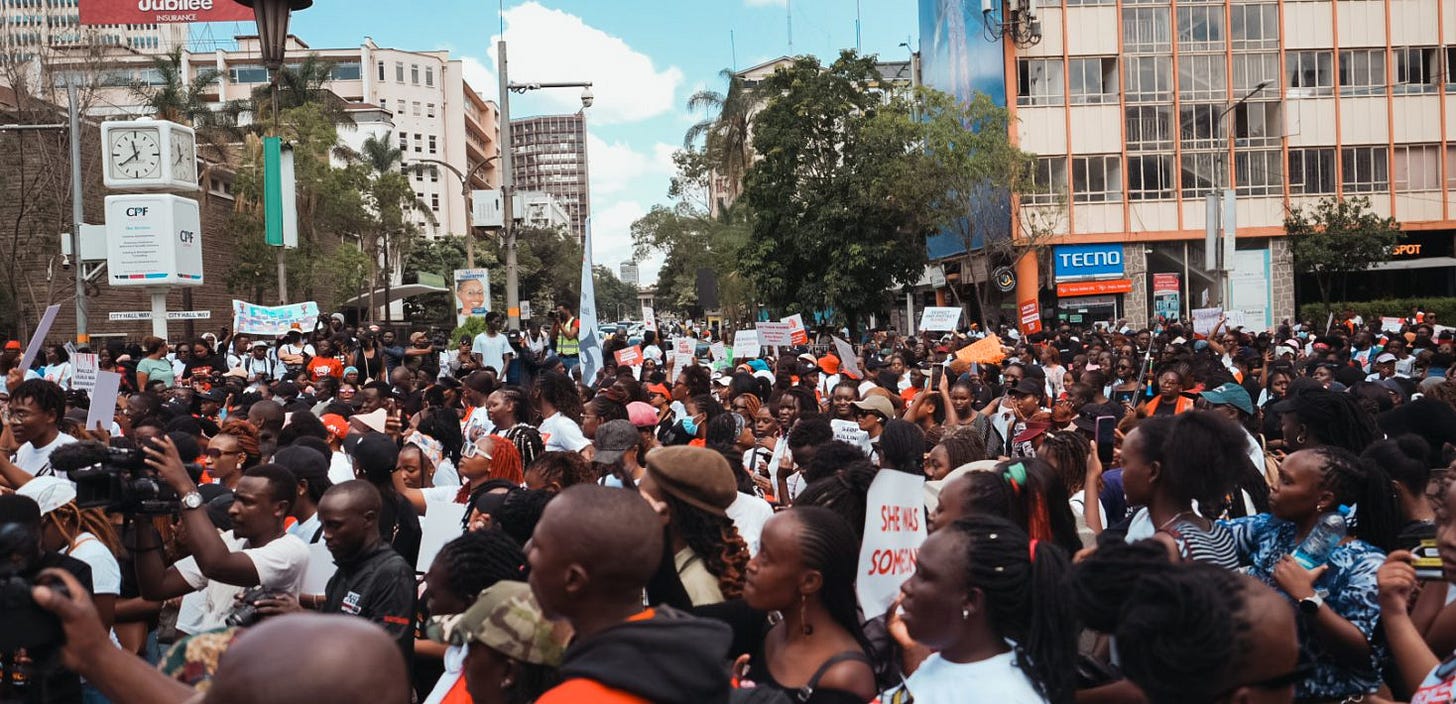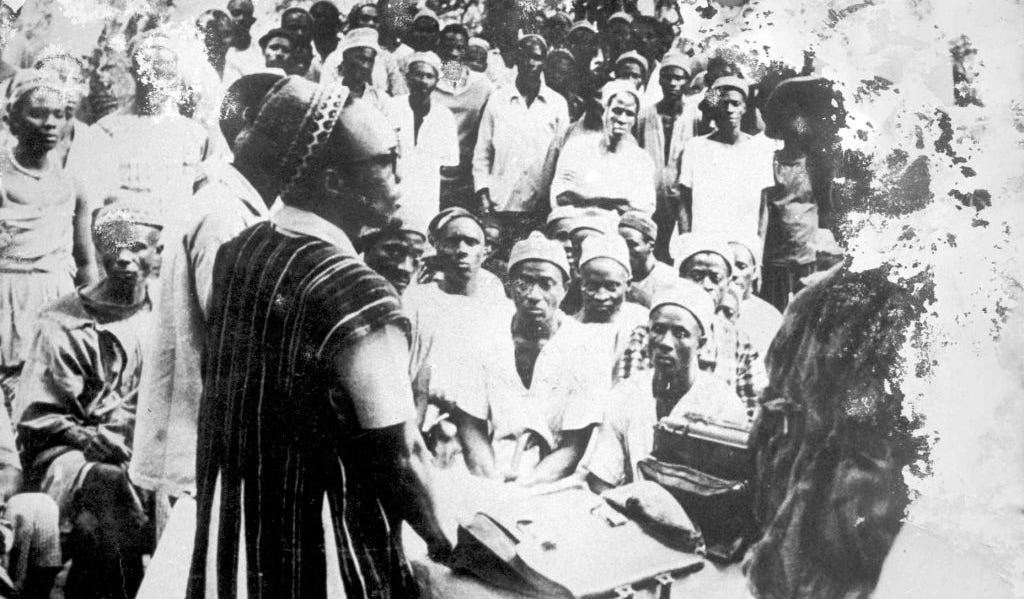Without strategy, solidarity is an illusion
Some questions for #RejectFinanceBill2024 protesters (including me)
On 25th June 2024 I found myself swallowed by us. Unlike the Thursday before when the police, teargas and clubs in hand, had atomised protesters making it difficult for us to form a critical mass, let alone gather in twos or threes, we were so densely packed, so overwhelming that it was impossible to see where we began and where we ended. I was at once in awe of our power, the efficacy of our collective mobilisation skills and humbled by the persistence of contradiction – the ways it could still generate fault lines, whether or not we chose to recognise them. While we were dancing, gathering and communing, the mostly dispossessed young men and women among us who were manning the frontlines, were attempting to and then succeeding in occupying parliament. They transmuted that same sweet protest into a bloody, painful, militant confrontation with the state.
On that same day, as many of us were able to go home safely, Githurai 45, a low-to-lower middle-income neighbourhood was attacked by the state – mama mbogas on their way home, children sleeping or doing their homework. For those residents, there was no way to demarcate the line between private and public spheres - the police ensured the two bled into each other - that risk could not be opted-out of.
At the edge of our protest, where the state was heightening the stakes of what it means to put one’s body on the streets, a splintering emerged.
Resistance is not a risk-taking contest, yet those two moments demonstrate that the risk of resistance is almost wholly hoisted upon the already precarious. Undemocratic uptake and distribution of risk is produced by the state’s violent and neglectful disposition towards the country’s working and under-classes. The conditions and the principled courage that would push someone to occupy a frontline, to storm a heavily militarised zone and the ease with which the state might teargas a residential area emerge from the same root: the long, state-enabled precaritisation of the poor majority. But within the context of a multiclass coalition, this non-distribution of risk, its de facto allocation to the working classes is in part produced by the cynical acceptance of this long precaritisation. Put another way, it is what we implicitly tolerate when we repeatedly say “some people have little/nothing to lose” with no intention to disrupt that calculus.
But, if we are insistent on the fact of this movement’s collective spirit, then we must be interested in what it might mean to democratise risk - to refuse its continued outsourcing to the always already marginalised; what it might mean to reposition the uptake of risk as a form of solidarity - solidarity that goes beyond the aesthetic performance of cohesion, solidarity that goes beyond professional caretaking or the extension of the our trades to the ground without what James called “merging with the masses” – a process that results in strategy.
Analysts of the #rejectfinancebill2024 protests distinguish the movement based on its ability to attract wide-ranging support from people who would not usually support civic disobedience - business communities, older generations, professional class and affluent people etc., as well as its organisation around the defence of civic processes, institutions and documents. Because of its neo-colonial character (it was co-developed by the national government with the International Monetary Fund), the 2024 Finance Bill posed threats to every sector of Kenyan society. The bill included clauses that endangered industries and banks by imposing a 16% value-added tax on financial transactions and increased the cost of manufacturing and importing goods by imposing an eco-levy of Ksh. 150 per kilogram of plastic packaging material. And it also included clauses that would give the Kenya Revenue Authority the unfettered power to surveil the bank and mobile money accounts of an already highly taxed population and application of VAT to staple goods such as bread. Furthermore, the bill represented the arrogance and neo-colonial capture of the political class – the fact that they are more willing to sacrifice the wellbeing of the whole country and ignore the loud rejection of the bill expressed through formal participation in public participation exercises than reduce the amount of public theft they engage in or refuse the advice of the IMF who are purely interested in securing debt repayment for Euro-American debtors. The bill threatened diverse actors, so necessarily, a coalition of diverse people emerged in its wake.
The coalitional character of the force that emerged to reject the bill, is in many ways what has made the protests powerful, impossible to ignore – the hundreds of thousands that have taken to the streets in thirty-seven counties, the availability of safe spaces in small businesses and religious institutions in the CBD, the momentary acceptance and endorsement of disruption that would typically have been rejected by those whose lives are being interrupted, the participation and exchange of legal and medical aid by professional associations and collectives and the mutual aid contributions to the loved ones of those who have been murdered or maimed by the state, the refusal to be cowed by the state’s weaponization of (tribal, social class, sexual, gender) difference to consolidate its power. In many ways care is a kind of resistance – a method adapted to interrupt the state’s immediate violence, exacted through the bullet, the jail. And within Kenya’s neoliberal context, the extension of care also works to disrupt the long, slow violence of the privatisation of the public healthcare system, the corporatisation of legal aid, and the limitation of the extension of financial care by the constraints of the nuclear family. The politicisation of care has been used to interrupt the transformation of care into a service only accessible upon payment or extraction.
Yet, if care can be resistance, if it has the capacity to push movements forward then our care as nurses, parents, teachers, lawyers, journalists, writers, doctors, community workers, also has the power to maintain the current structures of power. And the distribution of risk along the same fault lines that structure capitalist Kenya, speak to that maintenance. Rephrased as two questions what I am noting and asking is: are we making the world anew if the impulse to extend care is driven by individual professional, patriotic or charitable commitments and not a collective strategy that is generated from “merging with the masses”? Is what we are offering solidarity or charity if those who are risking everything to confront the state are the same ones who experience the brunt of state violence every day?
Political theorist Joy James’ theorises the concept of the captive maternal to think about care’s function within the context of resistance. It helps us think through the extent to which care is used to resist and protect communities against state and imperial predation or alternatively the way in which care can be co-opted to maintain and strengthen the violent state, empire and capital. James is clear that “the identity of the caretaker has no inherent value without an investment in care that becomes politicized through function”, therefore the “captive maternal is a mobile function” and that function can evolve through several stages of incremental development:
· Stage 1, Caretaker: where a captive maternal cares for their immediate community or family and/or is fulfilling professional duties that include care then protest
· Stage 2, Protesters: captive maternals who engage in acts of refusal, beyond conventional, everyday caretaking.
· Stage 3, Movement-makers: organised captive maternals who create communities that resist state predation *together*
· Stage 4, Maroons: A community of captive maternals who create autonomous zones together where they have access to free food, education, medical care, accessible greenery and self defense.
· Stage 5, War Resisters: Given that the state firmly represses maroons, war resisters emerge to protect their autonomous zones. In this stage the captive maternals actions are shaped by a commitment to confronting the state in order to achieve a collective vision and protect communities from state predation.
Importantly, these stages are not meant to depict a hierarchy of importance – they describe a trajectory for resisting while escaping co-optation and reinscription of hegemonic power. To me, James aims to illustrate what kinds of struggle are possible when we become more dedicated to collective struggle that is guided by strategy and discipline. In summarising the limitations of care, James writes, “the hubris of the captive maternal is to think that care can remedy all imbalances”. Here, James is observing how those of us who extend care professionally, in community, in protest or movements believe that care in and of itself is enough to liberate and alleviate the extensive, strategically manufactured consequences of capitalism, imperialism and cisheteropatriarchy – more elaborately, we mistake the consequences of cisheteropatriarchy, capitalism and imperialism – poverty, houselessness, illness, undereducation etc. – as the root of these systems. In turn, we believe that to alleviate these consequences, we simply have to deliver care.
Instead, what James argues is that care, when it is not a tactic shaped by strategy, becomes vulnerable to coaptation and weaponizable and in our case, in the #RutoMustGo movement, care can sometimes be used to reinforce the same hierarchies that frame the world we are working to interrupt. To offer care, free of charge to people that the state wishes to eliminate is radical and important to be clear, but when it is offered of one’s own will and not as part of a cross-class collective strategy to confront and eradicate capitalism and colonialism, it runs the risk of turning into professional caretaking or assistance – “assisting, feeding, educating the poor while the empire remains intact to impoverish, starve and violate the new crop of captives”.
In describing how witnesses to the lynching of George Floyd could record but not interrupt his murder in her book New Bones Abolition, Joy James writes that “despite our care, emotional intelligence, and political determination, without collective strategies, our caretaking freezes or falters”. For example, for us in Kenya, aid was being rendered in the event of state attack or murder – assistance – but aid was not being prepared to prevent the attack or death in the first place – what James is saying is an impossibility without collective strategizing, only possible if we “merge with the masses”. What kind of arrests and disappearances might we have been able to challenge if self- and community- defence were key to our strategy? How might we have collectively ensured that the frontlines of protest did not further precaritise the already-precaritised? Another example, on June 27th prior to the scheduled Occupy State House march, many of us including myself repositioned cowardliness as strategy. So when people, largely precarious young people, decided to make good on the plan, we offered reactionary, fear-based advice about State House being a protected zone, that worked to reinforce the state’s attempt to wield the law in order to distance itself and in turn further withhold power from the Kenyan people. How might organisation have enabled us to develop practical visions of safety for those who felt called to take that action – a framework for safety that still allowed for the destabilisation of state power? Would our own anxieties have been calmed had we planned together? And even if it was a dangerous action, might strategizing have supported us in finding out whether it was a principled risk, worth taking?
Many of us insisted that collective strategizing was a sure pathway to co-optation, but if we think with James, the absence of a strategy is what made it difficult to move our movement from one stage to the next.
Ultimately, James makes clear that care that is not disciplined by collective agency, communal ethics, collective strategy and political will – how she defines ‘agape love’ – is often the type of care that is most vulnerable to co-optation and therefore less capable of moving the collective towards liberation. Therefore, it follows that if risk is inherent to any action that truly destabilises empire, those who are willing to take on calculated risks and commit to create and apply strategy in order to strengthen their movements, and bring the collective closer to dissolving empire, are also those who are most disciplined and most open to communing and thinking together. Their actions are determined by collective political will, by agape love, not their own aspirations or fears. And while James notes that those who tend to be most strategic and open to applying strategy particularly when risky – the war resisters, the maroons – are those who are most precarious, the potential for development as a captive maternal means that strategizing and the cultivation of commitment through gathering and organising rather than simply mobilising, means there is a way to challenge the extension of the state calculus that renders the already-precarious disposable to the streets and the movement.
For those of us who are not working class, not precarious – who can survive and perhaps even thrive under capitalism’s individuation – we cannot simply view the captive maternal as a stable, easy bridge into movements. We have to view it as a direct challenge to the apathetic complicity that is tacitly displayed when we admit that those who are at the frontlines are simply those who have “nothing to lose”. We have to view it as an invitation to join the collective in the long term, in order to democratise risk, a critical element of solidarity. What might “merging with the masses” require of us? What possibilities for solidarity might emerge when we take our queues from real, strategic collective political will, rather than its illusion?







The way the politics of the AU chairmanship just turned out made this piece a lot more impactful.